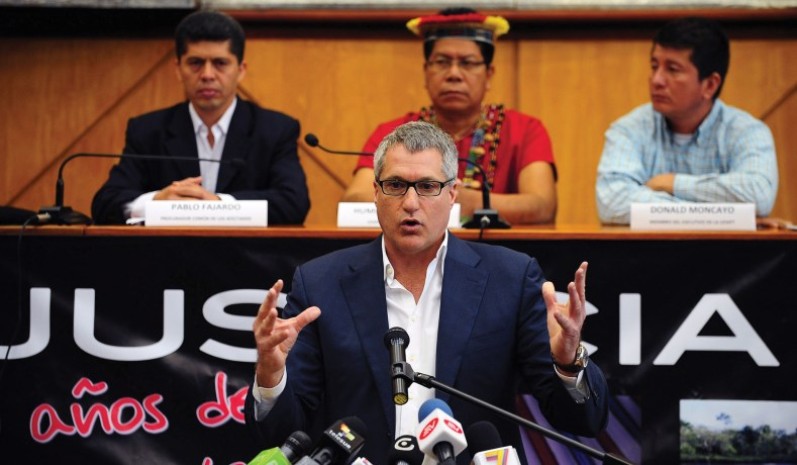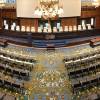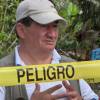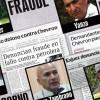Caso Chevron
Steven Donziger and the Plot against Chevron
The outtakes had a happier ending than the movie
National Review 10/10/2019

Steven Donziger speaks in Quito, Ecuador, March 19, 2014. (Rodrigo Buendia/AFP/Getty Images)
This was not the heroic ending that Steven Donziger had envisioned, wanted, deserved. The Harvard-educated environmental lawyer and liberal activist — the scourge of Big Oil, the Left’s rainmaker — was, after all, the moral mastermind behind one of history’s most staggering legal judgments. He was going to land a blow for Mother Earth, crush the evil Polluters, make them pay — a lot — and then take bows.
They make movies about guys like Steven Donziger, don’t they?
They do. And they did.
In hindsight, they probably wish they hadn’t, because what the filmmakers left on the cutting-room floor ended up not as debris in a trash barrel but as evidence in a federal courtroom. And Steven Donziger ended up not as a liberal hero who brought a corporate giant to its knees but as a broke attorney, his license suspended, his ankle clamped with an electronic bracelet, his passport confiscated, his reputation recast as that of a champion scammer in the annals of American jurisprudence. Once the Oscars beckoned. Now it’s the jailhouse.
Some context first: Whether depicted on film or in a book or even at a federal RICO trial, the principal settings for this tale are a New York courtroom and a region of Ecuador that environmental activists dub “Rainforest Chernobyl.”
In Ecuador’s northeast, where the Amazon jungle stretches towards the sea, Texaco, the iconic American company known for the trustworthy Man Who Wears the Star, had a hunch that there was oil underfoot. Exploration started in 1964, and the hunch proved correct: Oil was struck in 1967. Construction of a pipeline, roads, and other infrastructure took a few years, but come 1972, drilling and pumping began. And there was plenty to pump: By the time its concession expired in 1992, Texaco had taken a billion-plus gallons of crude from the Lago Agrio field. The project enriched the company, and the country’s elite: By the late 1970s, the government was the operation’s majority shareholder, and by the early 1990s, PetroEcuador — which continues to drill and spill in good-enough-for-government-work style — was the sole proprietor.
When its lease ended, Texaco began the process of cleaning up its share of the drilling sites and pits where sludge and other nasty materials extracted during the dirty drilling process had accumulated. With government oversight and approval, Texaco’s remediation obligations were met and certified. The company received its release.
And that’s when a historic legal fight — now in its 27th year — commenced. In 1991, environmental activist Judith Kimerling wrote Amazon Crude, an influential book that condemned the impact of oil exploration on the rainforest. The tome inspired New York attorney Cristobal Bonifaz to do what lawyers do: He filed a class-action federal suit in New York on behalf of Ecuadorian natives, claiming harm from Texaco’s alleged failure to remediate.
Into this affair he brought amigo Steven Donziger. Donziger was a big guy in every way, matching the affair’s scope with the largeness of his own persona and the brazenness of his legal mindset.
The man who was now battling Texaco (and, eventually, Chevron, which bought its former competitor in 2002) was a textbook liberal goody-two-shoes. In his beret-wearing years while attending Harvard Law School, Steven Donziger projected a radical-chic persona and compiled a bleeding-heart résumé. An American University alumnus, he worked as a journalist in Central America before heading to Harvard, where his liberal cool fell in with that of classmate Barack Obama. Upon graduation he served as a public defender in the District of Columbia, founded Project Due Process to advocate for Mariel-boatlift detainees, was a director of the National Criminal Justice Commission, and wrote copiously on criminal-justice and environmental matters. He was a professional liberal with a yearning for the spotlight.
The Texaco/Chevron lawsuit provided him one. It was an opportunity made for his talents and beliefs, and his sense that flair mattered. The case, as Donziger envisioned it, would be fought as much in the public arena as in courtrooms.
After courts ruled that Ecuadorians had no standing for the class action in America, Donziger turned to Ecuador’s courts, where a new suit was filed. Buttressing the legal effort was a concerted PR campaign to portray Chevron as a greedy corporate polluter whose profits came at the cost of cancer and other illnesses plaguing the region’s poor and powerless. Was this a calculation to shake down the oil giant? If it was, it didn’t work. But Donziger’s plan to generate publicity did. Celebrities flocked to hashtag campaigns and took rainforest sojourns to be photographed waxing indignant at oily gunk and muck. The likes of musicians Sting and Roger Waters (of Pink Floyd) and actors Danny Glover, Mia Farrow, Cher, and Daryl Hannah embraced what was becoming a cause. Vanity Fair ran a massive 2007 essay covering the suit.
A big score for Donziger followed: In May 2009, 60 Minutes aired Scott Pelley’s “Amazon Crude” segment. An even bigger score came that September: Acclaimed filmmaker Joe Berlinger (Making a Murderer, Metallica: Some Kind of Monster, and many others) released his documentary Crude. This film about the lawsuit made the festival circuit and racked up numerous awards, while movie critics from major press outlets — the Los Angeles Times, Boston Globe, Philadelphia Inquirer, Washington Post, and dozens more — were ink gushers. The New York Times critic said:
Like almost every other recent documentary on a politically charged topic, “Crude” does not pretend to neutrality. Yet while Mr. Berlinger’s sympathies clearly lie with the oddly matched pair of lawyers — Steven Donziger, a big, outgoing American, and Pablo Fajardo, a wiry, diffident Ecuadorean — who are consumed by the now 16-year-old suit against Chevron, he is fair-minded enough to include rebuttals from the company’s executives and in-house environmental scientists.
It’s what Berlinger didn’t include in the film that turned the worm.
The Crude project was a major commitment for Berlinger, who filmed hundreds of hours of footage over a three-year period. Just before its release, Paul Dans, an attorney hired to do contract work for Chevron, caught Crude’s two-minute trailer and felt compelled to watch it repeatedly. Something Donziger said in the clip, referring to a legal tactic — “This is something that you would never do in the United States” — made Dans think Donziger “might have checked his ethics at JFK.”
As author Michael Goldhaber recounted in Crude Awakening: Chevron in Ecuador, Dans flew back to the United States from Europe on the day of Crude’s premiere, determined to see it. What he saw troubled him:
Dans focused on an innocent scene where Donziger let his dog frolic in Riverside Park. Dans knew the location well; he lived two short blocks from Donziger and jogged every evening past the same park bench. What struck Dans was that the dog was off leash in a park where leash laws were strictly enforced. This is a guy who flouts the rules, he thought.
Back at his desk, Dans noticed that the director, Joe Berlinger, boasted in his production notes of shooting 600 hours of raw footage. If Donziger was so indiscreet in the final cut, he wondered, what might he do in the outtakes?
For want of a leash . . . This is as good a place as any to locate the beginning of the demise of the environmental movement’s emerging colossus. But Donziger and his clients still had some good days ahead of them: In February of 2011, the Ecuador judge ruled against Chevron. The staggering judgment awarded was $18 billion.
Chevron was in no mind to pay it, or to settle. Instead, it was determined to fight, salting a little earth where deserved, and to win. It would do so, demonstrating along the way that:
- The Ecuadorian court’s independent expert assessing damages, Richard Cabrera, submitted a report that had in fact been written by the U.S. environmental consultants (one of whom played a big part in the 60 Minutes episode) hired by Donziger.
- Cleanup engineers declared that Donziger had lied about well-site contamination and that plaintiffs’ lawyers had submitted reports to Ecuador courts that falsified evidence and forged signatures.
- Nearly half the plaintiffs of the initial suit had their names forged on the filing, with the lead plaintiff, Maria Aguinda, contending she had signed a document believing she was receiving free medicine, not becoming part of a suit.
- The scientist hired by the plaintiffs to assess Texaco’s drilling admitted in an affidavit that there was no evidence linking any health problems to Texaco’s operations, that the environmental evidence did not support the plaintiffs’ claim, and that “Donziger is lying.”
The company filed civil suit in federal court in New York in 2011, contending that the Ecuador court’s verdict was the result of a fraudulent scheme perpetrated by Donziger, his paid consultants, and the Ecuadorian judges. Judge Lewis Kaplan, a Clinton appointee who had overseen several Mafia racketeering cases, presided over one of the more dramatic proceedings in recent memory, as a series of witnesses and consultants — although not Donziger, never Donziger — admitted that they had lied, taken bribes, committed extortion, had their names used on falsified documents, and much more.
Dans had been onto something about the Crude outtakes. In the 500 hours of cutting-room debris, which the judge ordered the filmmaker to turn over to the defense, was a trove of Donziger’s self-indicting utterances showing that the case had been doctored, the judges and experts bribed, and the legal representation a criminal operation. Among the celebrated lawyer’s recorded clips:
“Facts do not exist. Facts are created.”
“We need to make facts that help us, and the facts we need don’t always exist. . . . And if they don’t exist in the obvious way, you gotta go figure out how to make them.”
“The only language this judge is going to understand, I believe, is one of pressure, intimidation, and humiliation.”
“We have concluded that we need to do more, politically, to control the court, to pressure the court. We believe they make decisions based on who they fear the most, not based on what the laws should dictate.”
The declarations about manufacturing evidence were complemented by investigation, as Chevron attorneys uncovered copious evidence damning Donziger and his team. The 20-day trial featured scores of witnesses, excruciating cross-examinations, and a staggering amount of evidence. In March of 2014, Judge Kaplan rendered a 485-page verdict that took no prisoners. It vindicated Chevron while charging Donziger with masterminding a criminal racketeering operation.
And this is where the case stopped being about Chevron and started being about a judge who had seen evidence of a crime and declared that the Racketeer Influenced and Corrupt Organizations Act (RICO) was suited as much for Steven Donziger as it was for the local capo.
Was anyone listening? Nothing happened. Not at first, anyway. Donziger should have been in an interrogation room, but instead he globetrotted, urging foreign governments (Canada, Brazil, Argentina) to permit him to fleece Chevron’s local subsidiaries. For six years, the U.S. Attorney’s office for the Southern District of New York had ignored or refused Kaplan’s entreaties for it to investigate and prosecute the man a Wall Street Journal editorial said had perpetrated the “legal fraud of the century.”
Maybe hell’s real fury is akin to a federal judge scorned. Following from his 2014 ruling, Kaplan had ordered Donziger to hand over to Chevron his computer, phone, laptop, and other devices. He refused. Ditto for Kaplan’s order that Donziger turn over his passport. Those decisions proved . . . contemptuous. On July 31 of this year, Kaplan issued an “order of appointment” in United States of America v. Donziger. It asked the defendant “to show cause why he should not be held in criminal contempt of court” and then leveled the rarely used (and, to many, little-known) Rule 42 of the Federal Rules of Criminal Procedure, which empowers a judge to appoint private counsel to prosecute a matter if the government refuses. Which he did (take that, Southern District!).
The same day, Kaplan issued a second criminal-contempt order, detailing five counts of Donziger’s willful disobedience of prior orders, and assigning the case to Judge Loretta Preska. Donziger will await trial — and his disbarment proceedings — in his New York apartment. While there, laid low, the once-upon-a-time hero can occupy himself contemplating Kaplan’s July 14 order that he pay Chevron $3,433,384.30 to cover attorneys’ fees.
There are ample lessons to learn from Donziger’s rise and fall and comeuppance, the kind rarely seen today. One, to flip the old joke, is that RICO is not only for guys named Rico. Sometimes it’s for guys named Steven. The other is to throw away the outtakes, even though sometimes they can be more entertaining than the actual movie.
Fuente OriginalNotas relacionadas
-
 Analysis: Liberal Media Lionize Anti-Chevron Lawyer Steve Donziger
Analysis: Liberal Media Lionize Anti-Chevron Lawyer Steve Donziger -
 Hace 5 años, Tribunal de La Haya falló a favor de Chevron
Hace 5 años, Tribunal de La Haya falló a favor de Chevron -
 ¿Quién es Richard Cabrera y cuál fue su rol en el fraude contra Chevron en Ecuador?
¿Quién es Richard Cabrera y cuál fue su rol en el fraude contra Chevron en Ecuador? -
 Disputa entre Chevron y Ecuador sigue viva en Holanda
Disputa entre Chevron y Ecuador sigue viva en Holanda -
 Ecuador fue condenado hace 4 años en La Haya por apoyar el fraude contra Chevron
Ecuador fue condenado hace 4 años en La Haya por apoyar el fraude contra Chevron -
 ¿Diez años después, dónde están los autores del fraude contra Chevron?
¿Diez años después, dónde están los autores del fraude contra Chevron?





